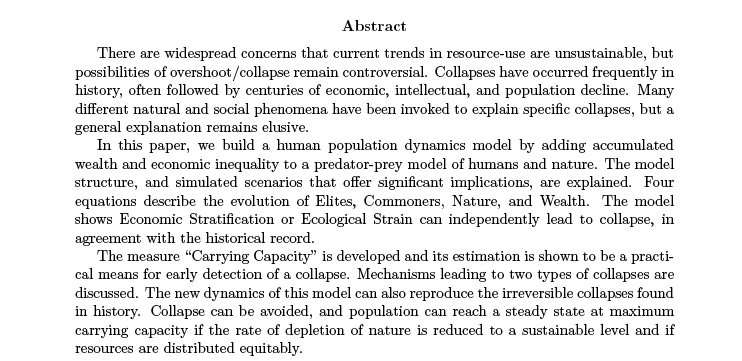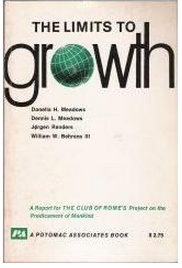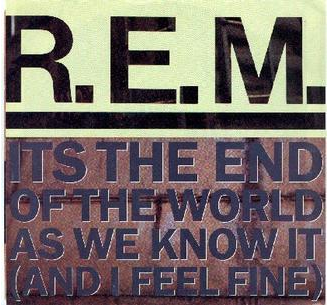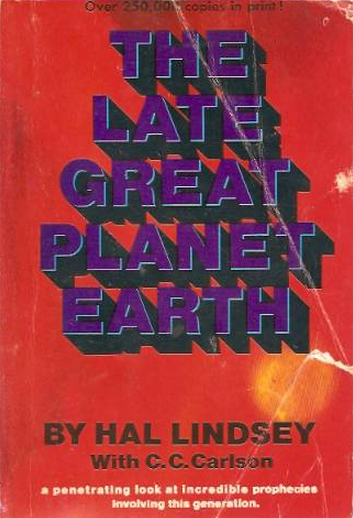It's the End of the World and I Feel...Conflicted.
 One of the more bizarre science-related stories last week had nothing to do with telescopes at the South Pole or the inflationary expansion of the Universe. Rather than focusing on the Beginning of Time, a flurry of activity was spurred by an allegedly "NASA-sponsored" study that addressed the End of Times.The story got its start when a draft circulated of a peer-reviewed article soon be published in the journal Ecological Economics. Its authors were two researchers from the University of Maryland - Safa Motesharrei (a graduate research assistant in Applied Math and Public Policy) and Eugenia Kalnay (faculty) - and Jorge Rivas, with the University of Minnesota (although his web site is out of service). Motesharrei, the prime author, is affiliated with the National Socio-Environmental Synthesis Center at U-MD which in turn is funded by the National Science Foundation.The title of their article gives some clue to the ensuing controversy: "Human and Nature Dynamics (HANDY): Modeling Inequality and Use of Resources in the Collapse or Sustainability of Societies." (abstract below for what I'll call the "HANDY paper").
One of the more bizarre science-related stories last week had nothing to do with telescopes at the South Pole or the inflationary expansion of the Universe. Rather than focusing on the Beginning of Time, a flurry of activity was spurred by an allegedly "NASA-sponsored" study that addressed the End of Times.The story got its start when a draft circulated of a peer-reviewed article soon be published in the journal Ecological Economics. Its authors were two researchers from the University of Maryland - Safa Motesharrei (a graduate research assistant in Applied Math and Public Policy) and Eugenia Kalnay (faculty) - and Jorge Rivas, with the University of Minnesota (although his web site is out of service). Motesharrei, the prime author, is affiliated with the National Socio-Environmental Synthesis Center at U-MD which in turn is funded by the National Science Foundation.The title of their article gives some clue to the ensuing controversy: "Human and Nature Dynamics (HANDY): Modeling Inequality and Use of Resources in the Collapse or Sustainability of Societies." (abstract below for what I'll call the "HANDY paper"). Their study was based on using a particular model - called H(uman) A(nd) N(ature DY(namics) or HANDY - to try to see mathematically whether contemporary society was susceptible to the sort of environmental or economic meltdowns that doomed earlier civilizations. The paper opens with a Jared Diamond-style summary of how earlier civilizations - Roman, Mesopotamian, Chinese, etc. - had all succumbed. The authors go on to detail their use of "four equations describ[ing] the evolution of Elites, Commoners, Nature, and Wealth." Their resulting model "shows Economic Stratification or Ecological Strain can independently lead to collapse." Such a fate "can be avoided...if the rate of depletion of nature is reduced to a sustainable level and if resources are distributed equitably."Normally, the appearance of a (draft) article like this would have been a non-event. But those words - inequality, collapse, equitably - somehow caught the attention of Nafeez Ahmed whose blog Earth Insight is hosted by The Guardian. Ahmed also helped create a 2011 documentary called The Crisis of Civilization which is about how global crises - economic as well as environmental - are the "converging symptoms of a single, failed, global system."
Their study was based on using a particular model - called H(uman) A(nd) N(ature DY(namics) or HANDY - to try to see mathematically whether contemporary society was susceptible to the sort of environmental or economic meltdowns that doomed earlier civilizations. The paper opens with a Jared Diamond-style summary of how earlier civilizations - Roman, Mesopotamian, Chinese, etc. - had all succumbed. The authors go on to detail their use of "four equations describ[ing] the evolution of Elites, Commoners, Nature, and Wealth." Their resulting model "shows Economic Stratification or Ecological Strain can independently lead to collapse." Such a fate "can be avoided...if the rate of depletion of nature is reduced to a sustainable level and if resources are distributed equitably."Normally, the appearance of a (draft) article like this would have been a non-event. But those words - inequality, collapse, equitably - somehow caught the attention of Nafeez Ahmed whose blog Earth Insight is hosted by The Guardian. Ahmed also helped create a 2011 documentary called The Crisis of Civilization which is about how global crises - economic as well as environmental - are the "converging symptoms of a single, failed, global system." On March 14, Ahmed wrote about the HANDY paper in an eye-catching piece titled "NASA-funded study: industrial civilization headed for 'irreversible collapse'?" Facebook shares (120,000+ so far) and tweets (8,000+) got the HANDY paper (and Ahmed) lots of attention. Stories about it appeared on NPR's web page, Popular Science and in major national newspapers with hyperbolic headlines like "NASA Predicts the End of Western Civilization".
On March 14, Ahmed wrote about the HANDY paper in an eye-catching piece titled "NASA-funded study: industrial civilization headed for 'irreversible collapse'?" Facebook shares (120,000+ so far) and tweets (8,000+) got the HANDY paper (and Ahmed) lots of attention. Stories about it appeared on NPR's web page, Popular Science and in major national newspapers with hyperbolic headlines like "NASA Predicts the End of Western Civilization". What struck me as most interesting was how media reports focused not so much on the content of the HANDY paper but on the fact that it was "NASA-sponsored." At a time when the space agency is increasingly beleaguered in some quarters, it seemed almost quaint that journalists would see the NASA imprimatur - which was not as firmly stamped as Ahmed suggested - as proof of quality. This seemed to harken back to the glory days of the Space Race when "NASA Made This" really meant something.As one might expect, there was a backlash. For example, Keith Kloor, writing on-line for Discover.com, critiqued not so much the HANDY paper's conclusions but the manner in which Ahmed was publicizing them. ((He also dug into the NASA funding issue. Eventually, NASA issued a denial that it had indeed sponsored the study or endorsed its conclusions. This was largely a non-issue, though. The draft article notes some support from NASA while a statement from National Socio-Environmental Synthesis Center explained "Motesharrei received minor support from NASA (Award No. NNX12AD03A), through UMD’s Earth System Science Interdisciplinary Center, to develop a coupled earth system model. Some of this funding was spent on the mathematical development of the HANDY model. The research paper was not solicited, directed, or reviewed by NASA. It is an independent study by the researchers utilizing research tools developed for a separate NASA activity.)) Ahmed counterattacked via blog in the social media version of wash, rinse, repeat...and here we are.Besides showing how social media and blogs can amplify a non-event into international handwringing, the hullabaloo around the HANDY paper is important for two reasons.One is historical. The HANDY paper - its methods, its conclusions, and the reaction to them - bears a striking resemblance to the 1972 Limits to Growth report.
What struck me as most interesting was how media reports focused not so much on the content of the HANDY paper but on the fact that it was "NASA-sponsored." At a time when the space agency is increasingly beleaguered in some quarters, it seemed almost quaint that journalists would see the NASA imprimatur - which was not as firmly stamped as Ahmed suggested - as proof of quality. This seemed to harken back to the glory days of the Space Race when "NASA Made This" really meant something.As one might expect, there was a backlash. For example, Keith Kloor, writing on-line for Discover.com, critiqued not so much the HANDY paper's conclusions but the manner in which Ahmed was publicizing them. ((He also dug into the NASA funding issue. Eventually, NASA issued a denial that it had indeed sponsored the study or endorsed its conclusions. This was largely a non-issue, though. The draft article notes some support from NASA while a statement from National Socio-Environmental Synthesis Center explained "Motesharrei received minor support from NASA (Award No. NNX12AD03A), through UMD’s Earth System Science Interdisciplinary Center, to develop a coupled earth system model. Some of this funding was spent on the mathematical development of the HANDY model. The research paper was not solicited, directed, or reviewed by NASA. It is an independent study by the researchers utilizing research tools developed for a separate NASA activity.)) Ahmed counterattacked via blog in the social media version of wash, rinse, repeat...and here we are.Besides showing how social media and blogs can amplify a non-event into international handwringing, the hullabaloo around the HANDY paper is important for two reasons.One is historical. The HANDY paper - its methods, its conclusions, and the reaction to them - bears a striking resemblance to the 1972 Limits to Growth report. Sponsored by the Club of Rome, Limits was announced with a media blitz aimed at policy makers and ambassadors, its “doomsday timetable” predicted an inevitable collapse of societies all around the planet unless politicians and business leaders had the courage to restrict the growth of populations, industrialization, and resource use. Instead of continued expansion, it called instead for economic and ecological equilibrium commensurate with a species wholly dependent on limited planetary resources. Extensive computer-based calculations by researchers from MIT provided the Club of Rome with evidence needed to support its bleak assessment of the future.Scientists and economists savaged the methodology that produced Limits, but the Club of Rome’s report sent a powerful message about a possible future. Its troubling conclusions compelled more than eight million people to buy copies of Limits and it was translated into some thirty languages. Limits fit the pattern of other eco-doom books that filled shelves in the late 1960s and throughout the 1970s. The 1970s were a very doomy time, in fact. Fears about the future were not just the province of activists, campus intellectuals, and ecologists. In the early 1970s, the Christian fundamentalist revival in the U.S. coincided with apocalyptic excitation about the future. In The Late Great Planet Earth, former tugboat captain Hal Lindsey used his own interpretation of the Book of Revelation to write what became the best-selling non-fiction book of the 1970s (and was made into a movie).
Sponsored by the Club of Rome, Limits was announced with a media blitz aimed at policy makers and ambassadors, its “doomsday timetable” predicted an inevitable collapse of societies all around the planet unless politicians and business leaders had the courage to restrict the growth of populations, industrialization, and resource use. Instead of continued expansion, it called instead for economic and ecological equilibrium commensurate with a species wholly dependent on limited planetary resources. Extensive computer-based calculations by researchers from MIT provided the Club of Rome with evidence needed to support its bleak assessment of the future.Scientists and economists savaged the methodology that produced Limits, but the Club of Rome’s report sent a powerful message about a possible future. Its troubling conclusions compelled more than eight million people to buy copies of Limits and it was translated into some thirty languages. Limits fit the pattern of other eco-doom books that filled shelves in the late 1960s and throughout the 1970s. The 1970s were a very doomy time, in fact. Fears about the future were not just the province of activists, campus intellectuals, and ecologists. In the early 1970s, the Christian fundamentalist revival in the U.S. coincided with apocalyptic excitation about the future. In The Late Great Planet Earth, former tugboat captain Hal Lindsey used his own interpretation of the Book of Revelation to write what became the best-selling non-fiction book of the 1970s (and was made into a movie).
Critics attacked Limits throughout the 1970s. Economists who assumed growth was a fundamental tenet of modernity proved particularly hostile. Demand for resources, critics said, was historically contingent. Factory owners did not clamor for coal in the 16th century nor was uranium a desired international commodity until after 1945. As a result, Limits appeared to some people as just a reprise of old Malthusian ideas. Released in the absence of peer review with a public relations extravaganza did not help assuage skeptics. Moreover, the data underlying Limits wasn’t available for inspection which aroused scientists’ suspicions further. Even the analytical tools the MIT group used provoked ire. The computer cliché “Garbage In, Garbage Out,” although still relatively novel in 1972, typified many experts’ responses.Similar critiques of the 2014 HANDY paper have already appeared (here and here and here, for example) although the attacks seemed more aimed at Ahmed's hyperbolic approach rather than the research itself. (One of the points argued in my book The Visioneers was that Limits served to motivate a cohort of dreamers and visionaries who applied their engineering and science skills to try to circumvent its pessimistic predictions. I'd be curious to hear if any new efforts are catalyzed by articles such as the forthcoming HANDY paper.) The second reason why I think the HANDY article is important has to do with how we imagine doomsday scenarios. Like good science fiction, these tend to reflect not the future but rather the time in which they are put forth. In his 1992 book When Time Shall be No More, the late historian Paul Boyer surveys the history of apocalyptic thought in American culture. During the Cold War, the End would come via the flash of a thermonuclear explosion. Deténte and the environmental movement brought eco-catastrophism to the fore (as Jacob Hamblin so nicely writes about in Arming Mother Nature) as overuse of resources and overpopulation became the mechanisms of our demise.Today, the collapse of society, as the HANDY article details, is predicated on the growing distinction between the haves and have-nots as destabilizing inequities will lead to overconsumption of resources and eventual conflict. In short - not surprising given the rise of attention to the 1% vs. 99%, disparities in CEO/employee pay, the collapse of the middle class, ad infinitum. Studies like the HANDY article may not be guides to the future but they offer a penetrating glimpse into the present. Every era gets its doomsday mechanism it deserves.
The second reason why I think the HANDY article is important has to do with how we imagine doomsday scenarios. Like good science fiction, these tend to reflect not the future but rather the time in which they are put forth. In his 1992 book When Time Shall be No More, the late historian Paul Boyer surveys the history of apocalyptic thought in American culture. During the Cold War, the End would come via the flash of a thermonuclear explosion. Deténte and the environmental movement brought eco-catastrophism to the fore (as Jacob Hamblin so nicely writes about in Arming Mother Nature) as overuse of resources and overpopulation became the mechanisms of our demise.Today, the collapse of society, as the HANDY article details, is predicated on the growing distinction between the haves and have-nots as destabilizing inequities will lead to overconsumption of resources and eventual conflict. In short - not surprising given the rise of attention to the 1% vs. 99%, disparities in CEO/employee pay, the collapse of the middle class, ad infinitum. Studies like the HANDY article may not be guides to the future but they offer a penetrating glimpse into the present. Every era gets its doomsday mechanism it deserves.
